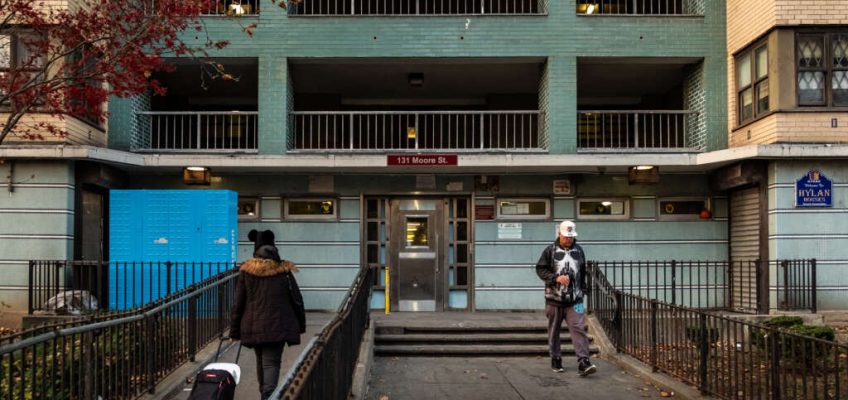“If AI is the next creative and economic medium, it must be in the hands of the New Yorkers who too often get invited last—public housing residents.”
NYCHA’s Hylan Houses. (Adi Talwar/City Limits)
New York City’s public housing communities have always been engines of culture, grit, and ingenuity. If we genuinely believe AI will shape the next century of work and creativity, then the front line for equitable access must be New York City Housing Authority (NYCHA) community centers, reimagined as neighborhood AI hubs that deliver training, credentials, and real economic mobility.
This isn’t abstract. New York is building the infrastructure to lead in responsible AI. Empire AI—a statewide public-interest supercomputing initiative housed at SUNY Buffalo—just moved into its next phase, expanding computer access to researchers across a 10-member consortium. Pair that with CUNY’s AI Academic Hub, now offering 170+ AI-focused courses and entry programs like “AI-One: CUNY AI for Everyone.” The spine is there. Now we need the capillaries: local, trusted access points in NYCHA community centers.
ChatGPT 5.0 is here. OpenAI’s newest flagship model is more innovative across coding, math, and real-world tasks, and is now the default in ChatGPT and rolling into developer and enterprise tools. Technology is quickly advancing and changing the way society functions and how people will perform their jobs. AI is not here to displace people from the workplace; it is here to welcome them and be more productive, if you know how to use it. It also offers a once-in-a-lifetime opportunity to utilize the technology to create businesses, jobs, and reduce poverty.
Despite near-universal availability of wired broadband, one in four city households lacked a fixed broadband subscription as of 2023, mostly in low-income communities like NYCHA. Many rely on cellular-only connections, limiting the kind of learning, coding, and portfolio-building that AI work demands. We need durable, local solutions that fuse access with training in low-income communities. An AI community-centered training model can fill that gap.
New York State has stepped in with consumer-protection moves to require low-cost internet service provider plans, but price alone won’t close a skills gap. An AI Hub in public housing would reimagine NYCHA community rooms, often used for a wide range of intergenerational programs, into dedicated, always-on technology centers.
Unlike the current NYCHA model, where activities span many topics, these hubs would focus intensively on one subject area: building AI and technology skills that lead directly to education, credentials, and jobs. Renovated or repurposed in underutilized community spaces in neighborhoods most in need, each hub would be equipped with high-speed broadband, modern devices, and on-site coaching staff to guide learning, along with connections to technology companies and community partners.
The curriculum would align with CUNY certificates and the SUNY/CUNY Reconnect program’s high-demand fields, including data, health technology, IT support, and green tech. Residents would gain hands-on experience with GPT-5-level systems (and others) for coding, data analysis, design, entrepreneurship, and assistive AI, with practical applications for resumes, small-business automation, and creative portfolios.
From these neighborhood hubs, learners could transition into internships and applied research projects, with tailored pathways for first-generation students, career changers, and those without prior degrees, or direct fellowships with employers. The program would build on Soulful Synergy’s decade of workforce training experience with over 11,000 people trained and over 15,000 certifications earned.
Its partnership with the Public Housing Community Fund, through the NYCHA Technology Academy, is delivering instruction rooted in the community and responsive to employer needs. These hubs would ensure that the future of AI in New York City and beyond evolves in a way that does not harm low-income populations and provides the most incredible opportunity to access technology and jobs.
Public housing communities produce the art, music, food, fashion, and small businesses that define New York. By definition, public housing also serves the lowest-income people. If AI is the next creative and economic medium, it must be in the hands of the New Yorkers who too often get invited last—public housing residents. An AI hub model compresses the distance between inspiration, training, credentials, and a first paid project right in the neighborhood.
The moment could not be more urgent. New York has already laid the foundation: free community college for adults in high-demand fields, a statewide public-interest AI supercomputer, a public university system rapidly scaling AI coursework, and a city wiring public housing for high-speed internet. What’s missing is the last mile—the trusted, accessible local hubs that can transform AI’s potential into tangible resident opportunities for people that need it most.
Now is the time to plant the flag, commit resources, and build the partnerships that will ensure AI becomes the great equalizer it is meant to be.
Alex Zablocki is executive director at Public Housing Community Fund. Dwayne R. Norris is co-founder of Soulful Synergy.
The post Opinion: Plant the Flag, And Bring AI to Public Housing appeared first on City Limits.


Leave a Reply